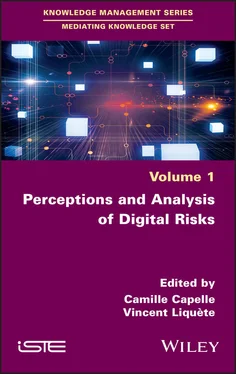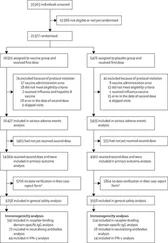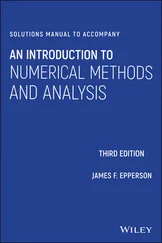1.3.2. Methodology and data collection
The survey conducted as part of the eRISK project took place between 2016 and 2019. Based on the typology of digital risks presented above, the survey explored the reported representations and practices of new teachers. The survey questionnaire, entitled “Enquête sur les pratiques numériques des enseignants” (survey on the digital practices of teachers), was distributed to all elementary school teachers and secondary school teachers, as well as principal education advisors in the academies of Bordeaux and Créteil, regardless of their seniority level. A total of 3132 teachers felt that this survey concerned them, and they responded in full. Among these 3132 respondents, 724 teachers were new teachers (i.e. the target of the study). We therefore analyzed the responses of these new teachers exclusively, with the idea of also being able to compare these results with those of more experienced teachers. This work is not covered here and may form the subject of a subsequent analysis.
It should be noted that the criterion of the number of years of experience is independent of the age of the teachers. Indeed, our panel of teachers interviewed was mostly under 35 years of age (72.4% of them), but the rest of the teachers were older, with most of them having changed careers. Following an initial analysis of the results, semi-structured interviews were conducted with 15 volunteers from the teachers who responded to the survey. The objective here was to present the major trends of the study to them in order to get them to react to them and explain their positions. This mixed data collection, both quantitative and qualitative, made it possible to refine and better understand some of the survey’s results, considering the diversity of representations around this subject.
The perceptions of digital risks were examined through the positions and discussions of the teachers interviewed. They relate both to their takes on their personal, often daily digital practices, and to their takes on their role as educators of young people. In order to see what conceptions of digital technology exist among this new generation of teachers and what status they afford to digital literacy, we sought to understand the diversity of these practices while aiming to identify sets of positions governed by common values, beliefs or principles.
1.4. Teachers’ perceptions of digital risks
Most of the teachers interviewed in the survey claim to use digital technology in an educational context: to prepare their lessons (93.9%), to communicate by e-mail with their colleagues (90.3%) and to illustrate their lessons (85.5%). The use of digital technology is therefore mainly for professional purposes, but is far less concerned with educating students in digital technology; only 49.4% declare that they train their students in digital technology.
By analyzing the interviews, three main sets have emerged that characterize the teachers’ discussions and positions:
– the first corresponds to teachers who renounce any practice of digital technology in the classroom, in particular because of certain perceptions of risk;
– the second concerns those who restrict the field of use for fear of being confronted with certain risks;
– the third group includes those who consider digital risks in the exercise of their profession and who seek to prevent them through education.
1.4.1. When perceptions of risk inhibit any practice
Certain perceptions of digital risks seem to be an obstacle. The use of digital practices with students is perceived by some as a problem factor, especially in their relationships with their parents. A schoolteacher explains his reluctance to have his students work on the Internet to us:
I’m not convinced of the parents’ response and I’m afraid of being annoyed, frankly, by the parents’ response. So, I’ve never used it and so, yes, that’s it (schoolteacher, 41 years old).
In secondary education, the use of social media platforms (including YouTube, social networks or blogs) is largely avoided, even though they constitute an important angle of media and information literacy. One schoolteacher expresses her difficulties in considering solutions for covering media and information literacy with her students:
It’s true that it’s very, very regulated, so, uh, even the blog, we’re not going to use just any blog, so it’s the academic blog and we’re obliged, it’s very formalized. So, it’s true that I know that it can be a hindrance, yes (fourth-grade schoolteacher, 25 years old).
This avoidance is dependent on their risk perception and on a kind of ethical principle that they apply to themselves as well as to the students:
I can’t get into it, first of all because I was probably reluctant to it, and the dangers it can bring. I saw when I was working in secondary school, we saw students’ Facebooks and what they put on them, and it’s unbelievable… So, for me, it’s more of a danger than a tool, in fact (teacher in pre-kindergarten, 44 years old).
An English teacher who is committed to educating students digitally explains:
There are many teachers for whom using digital networks, even Twitter, is too scary (English teacher in a high school, 25 years old).
Social networks are indeed perceived as spaces that must remain totally inaccessible at school, associated with “dangerous sites” and treated in schools, according to teachers, on the same level as “pornographic sites”:
When they go on the Internet, there are a lot of filters that prevent them from accessing a certain number of so-called dangerous sites. I don’t know how to talk about it... well, I don’t know how to talk to the students about these... risks, I mean. In fact, when they go on the Internet at school, they don’t have access to social networks, pornographic sites, sites… I don’t know, maybe dangerous sites, or so-called dangerous sites, in the educational world (art teacher in a high school, 29 years old).
We also see that the risks evoked for students are strongly influenced by their personal experience and the concerns they may have for themselves, such as here, on social networks:
But the problem with social networks is that they are very... it’s a bit of a vent for everyone and I don’t really like that system (management teacher in a senior high school, 39 years old).
These concerns crystallize around the use of social networks and the information disseminated or used on the Web. They are first projected onto the students, as expressed by this English teacher:
I just think that there is no limit in fact with the digital environment among students... and it goes over our heads. It goes over our heads, their heads and the parents’ heads, over everyone’s and uh... at the same time it’s addictive for them so... it’s addictive and it’s destructive at the same time and it’s risky, too. That’s why it’s really worrying (English teacher in a high school, age 25).
The cell phone is also a subject that gives rise to debate and apprehension within schools. Its prohibition in schools and colleges, apart from educational uses, has undoubtedly reinforced certain apprehensions among teachers, as expressed by this high school teacher:
Digital technology, for me, is something... I don’t know how far it can go. That is to say that... if I do a class with students, for example, and I ask them, which won’t happen, to use their cell phones, so there are 24 students or 28 students, since these are classes of 24 or 28, if I find myself with two, three students using their phones for purposes other than pedagogical purposes... not only will I not have the means to block them, I’ll have no way of knowing where it went, how it was broadcast or anything. Or what was broadcast. I won’t know until later, or by word of mouth. So that’s it, really, the fear of that. The fear of being filmed without one’s knowledge, the fear of that being sent on the Internet, on any type of social network it can be posted on and not having control over this post (aeronautics teacher in a high school, age 55).
Читать дальше












